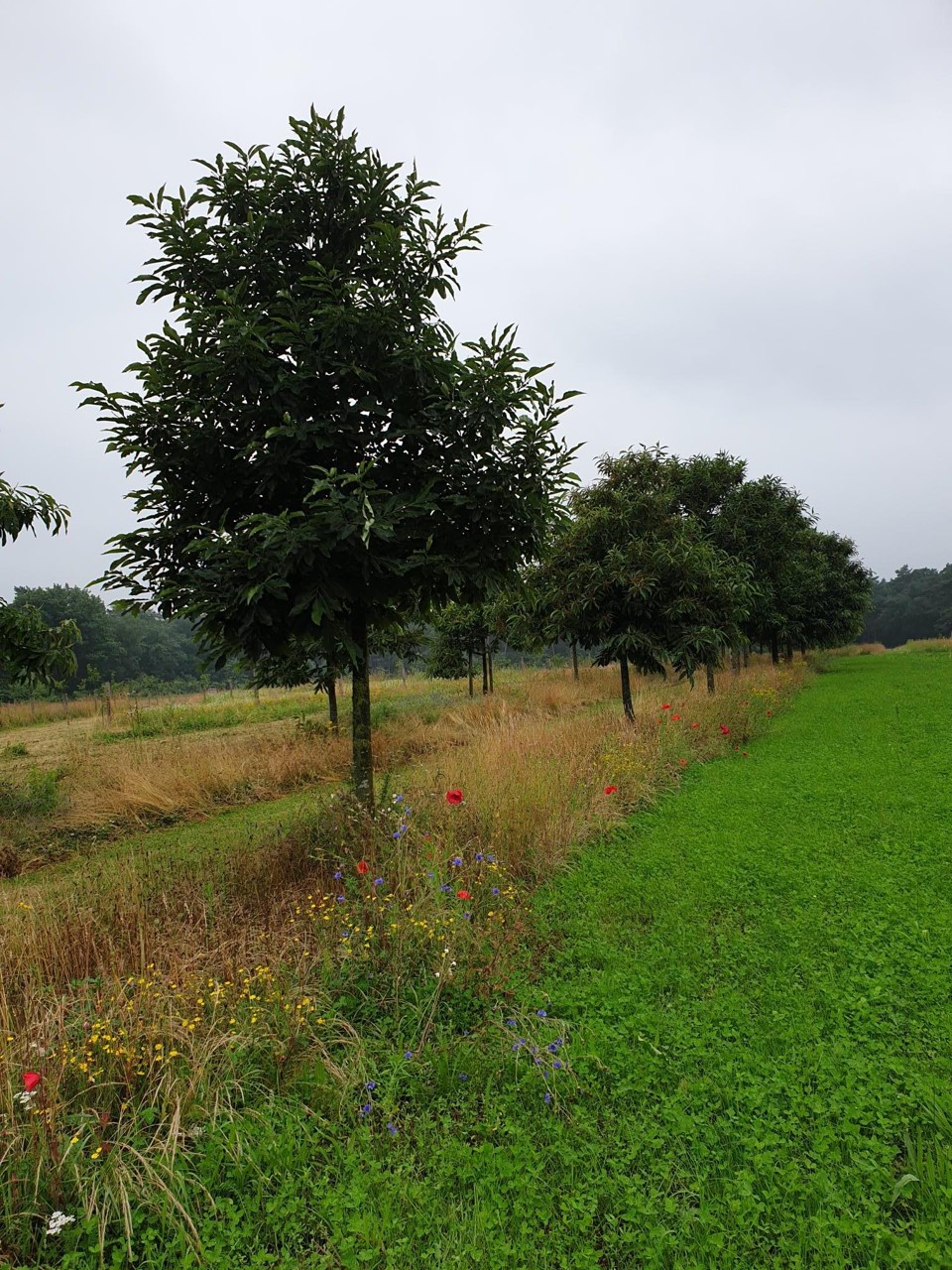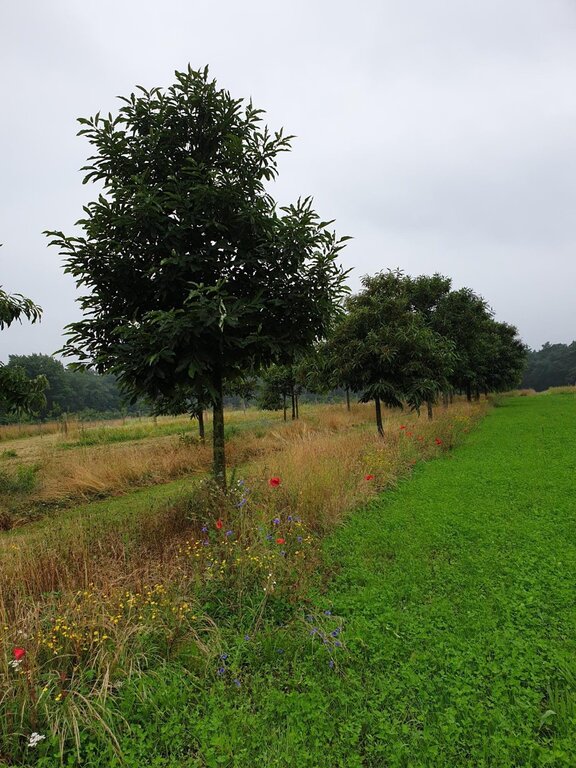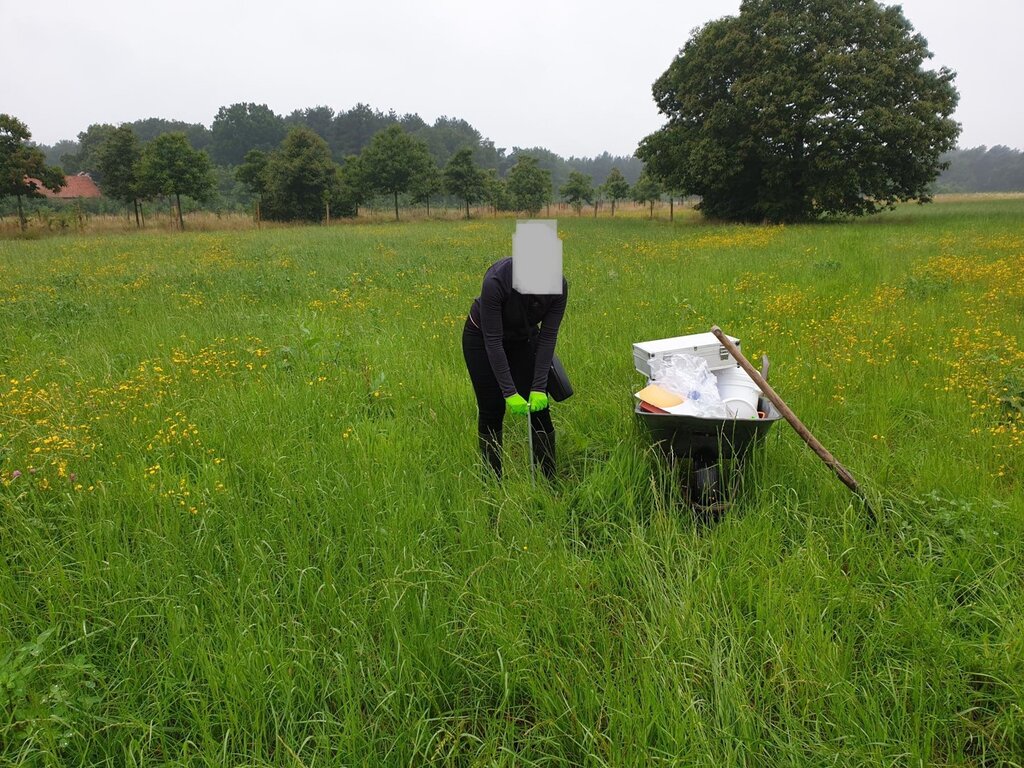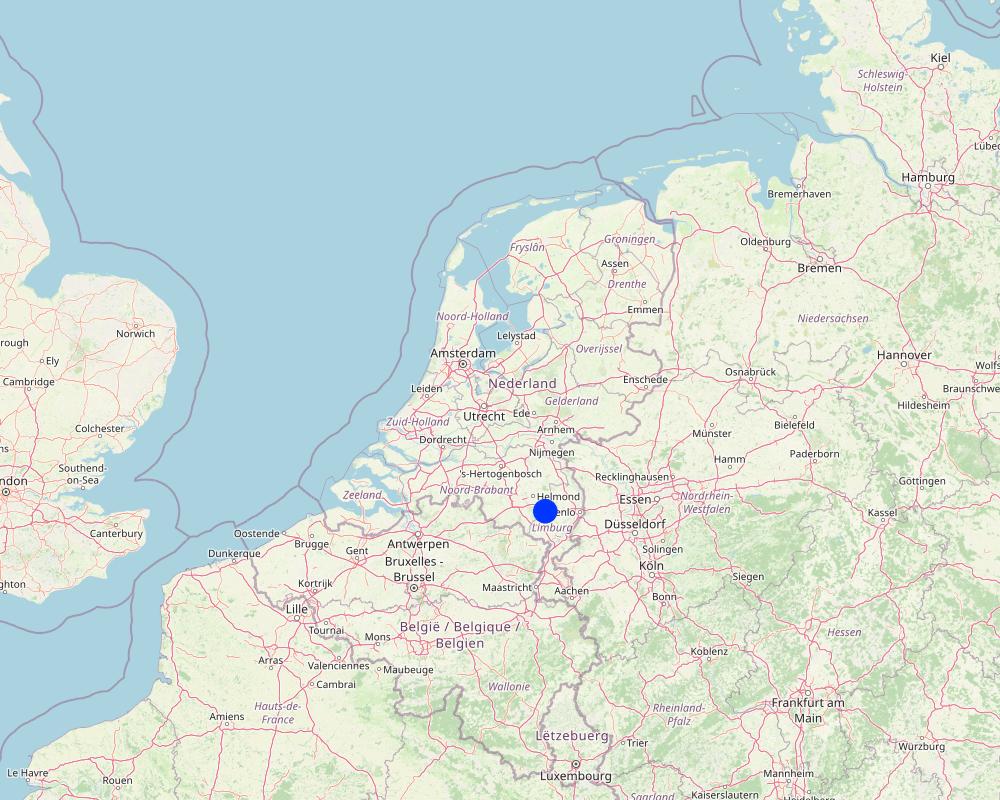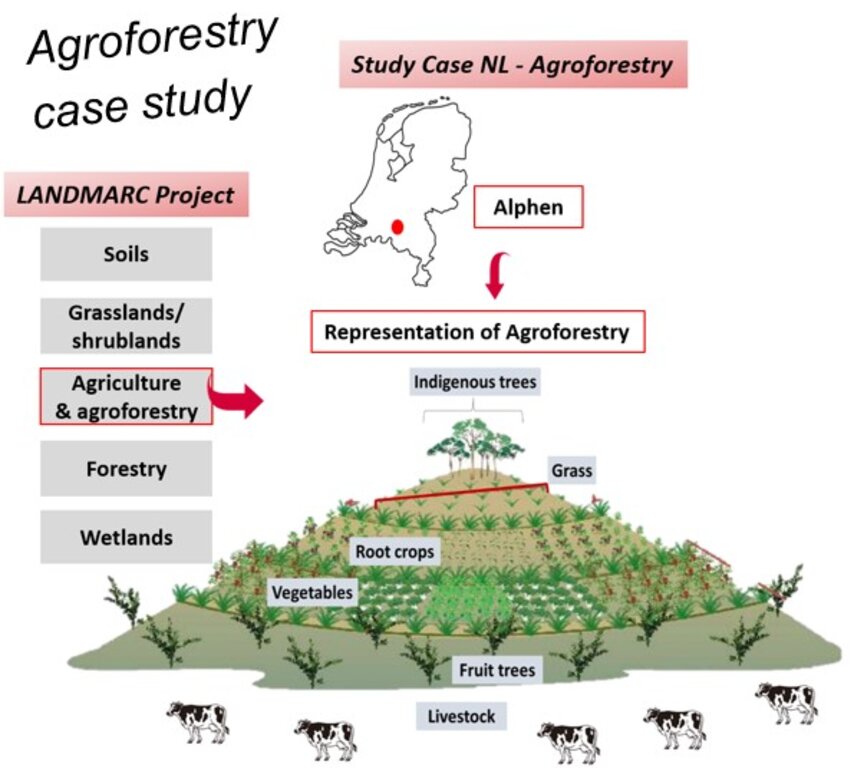Alley cropping with nut trees [荷兰]
- 创建:
- 更新:
- 编制者: Carlos Gil Picon
- 编辑者: –
- 审查者: Rima Mekdaschi Studer, William Critchley
Alley cropping with nut trees
technologies_7094 - 荷兰
查看章节
全部展开 全部收起1. 一般信息
1.2 参与该技术评估和文件编制的资源人员和机构的联系方式
关键资源人
SLM专业人员:
Gil Picon Carlos
Stichting Joint Implementation Network
荷兰
有助于对技术进行记录/评估的项目名称(如相关)
Land Use Based Mitigation for Resilient Climate Pathways (LANDMARC)有助于对技术进行记录/评估的机构名称(如相关)
JIN Climate and Sustainability (JIN-NGO) - 荷兰1.3 关于使用通过WOCAT记录的数据的条件
编制者和关键资源人员接受有关使用通过WOCAT记录数据的条件。:
是
1.4 所述技术的可持续性声明
这里所描述的技术在土地退化方面是否存在问题,导致无法被认为是一种可持续的土地管理技术?:
否
2. SLM技术的说明
2.1 技术简介
技术定义:
An agroforestry system consisting of rows of walnut and hazelnut trees combined with grassland and flowers was applied in place of a former conventional monoculture system in Alphen, Noord-Brabant, the Netherlands.
2.2 技术的详细说明
说明:
This agroforestry technology is applied on an organic farm located in the province of Noord-Brabant, Netherlands. Owned by a local farmer, the farm covers a total of 7.8 hectares. In 2018, this land was allocated for the Farm Life project, transforming it into agroforestry system. The farm integrates natural and agricultural elements, creating a sustainable environment where trees (chestnuts), crops, and pasture co-exist.
The agroforestry system on this farm is utilized for multiple purposes, including chestnut tree cultivation, agriculture, horticulture, and pasture. This diverse planting strategy allows the farmer to mix crop production with tree cultivation, where each component supports soil health and ecological balance. Chestnut trees, for example, are grown alongside mainly grasses, introducing perennial elements to the farm and diversifying the landscape.
Agroforestry merges natural ecosystems with agriculture, creating a system where nature actively enhances farm productivity. It allows farmers to move beyond monoculture farming by incorporating trees and shrubs into crop systems, promoting biodiversity as an essential part of farming. For example, integrating chestnut trees into these systems improves soil health, reduces erosion (as these are mainly sandy soils), and strengthens the farm’s resilience to environmental stress. This approach also creates income from products like chestnuts, which supports sustainable food production—a primary motivation for the farmer.
This agroforestry system, while beneficial, faces challenges in implementation and scaling-up. For example, perennial food crops are not yet commonly integrated into modern agroforestry systems, which limits their full potential. Establishing a guide on cultivation practices and securing better funding would be key steps to upscaling agroforestry production and making it more accessible. Additionally, adequate resources and guidance on plant selection, tree management, and harvesting methods would make it easier for farmers to adopt and sustain these practices.
Specifically to this agroforestry, compared to traditional fruit trees like apples and pears, chestnut trees require less intensive management—reducing labor as they naturally drop fruit and need less pruning. They also enhance biodiversity and can be financially beneficial. As a perennial carbohydrate source, chestnuts offer a sustainable, low-maintenance crop option that aligns with modern food production goals. Additionally, they can help revitalize traditional orchard landscapes and accelerate returns from forest areas through nut production, contributing to long-term ecological and economic benefits.
While agroforestry offers many environmental benefits, land users face several challenges. Initial investments in tree planting, maintenance, and management can be costly, and limited access to financial support often discourages smallholder farmers from adopting these practices. Some farmers also find the high diversity of species in agroforestry systems to be complex and challenging for achieving consistent product yields. There are also limitations in technology suited for small-scale agroforestry, such as a shortage of plant materials (e.g., seedlings) and limited guidance on establishing and maintaining agroforestry systems. On the positive side, farmers appreciate agroforestry’s contributions to a sustainable environment. The increased organic matter and diversity, improve soil health and crop productivity, and build resilience against environmental stressors, which makes agroforestry an option for long-term land management.
2.3 技术照片
2.5 已应用该技术的、本评估所涵盖的国家/地区/地点
国家:
荷兰
区域/州/省:
Noord-Brabant
有关地点的进一步说明:
Alphen
具体说明该技术的分布:
- 均匀地分布在一个区域
如果技术均匀分布在一个区域,则指定覆盖的区域(单位为平方千米):
0.078
技术现场是否位于永久保护区?:
否
Map
×2.6 实施日期
如果不知道确切的年份,请说明大概的日期:
- 不到10年前(最近)
2.7 技术介绍
详细说明该技术是如何引入的:
- 通过土地使用者的创新
3. SLM技术的分类
3.1 该技术的主要目的
- 减少、预防、恢复土地退化
- 保护生态系统
- 适应气候变化/极端天气及其影响
- 减缓气候变化及其影响
3.2 应用该技术的当前土地利用类型
同一土地单元内混合使用的土地::
是
具体说明混合土地使用(作物/放牧/树木):
- 农林业

农田
- 乔木与灌木的种植
乔木和灌木种植 - 指定作物:
- 树坚果(巴西坚果、开心果、核桃、杏仁等)
每年的生长季节数:
- 1
采用间作制度了吗?:
是
采用轮作制度了吗?:
否

牧场
动物类型:
- 牛 - 奶制品
产品和服务:
- 奶类

其它
具体说明:
flowers
3.3 由于技术的实施,土地使用是否发生了变化?
由于技术的实施,土地使用是否发生了变化?:
- 是(请在技术实施前填写以下有关土地利用的问题)

农田
- 一年一作
年作 - 具体指明作物:
- 根/块茎作物 - 土豆
采用间作制度了吗?:
否
采用轮作制度了吗?:
否
3.4 供水
该技术所应用土地的供水:
- 雨养
3.5 该技术所属的SLM组
- 农业林学
3.6 包含该技术的可持续土地管理措施

植物措施
- V1:乔木和灌木覆盖层
- V2:草和多年生草本植物

管理措施
- M1:改变土地使用类型
3.7 该技术强调的主要土地退化类型

土壤水蚀
- Wt:表土流失/地表侵蚀

生物性退化
- Bh:栖息地丧失
- Bp:害虫/疾病增加,捕食者减少

水质恶化
- Hq:地下水水质下降
注释:
The implementation of agroforestry in this case study intends to increase soil properties by restoring soil biological cycles, providing habitat for predators that can reduce pests, and reduce nitrate leaching to improve nutrient retention and avoid the leaching of nitrates.
3.8 防止、减少或恢复土地退化
具体数量名该技术与土地退化有关的目标:
- 防止土地退化
- 减少土地退化
4. 技术规范、实施活动、投入和成本
4.1 该技术的技术图纸
技术规范(与技术图纸相关):
The system consists of a flat area of around 7.8ha where nut tree alleys have been implemented. The separation between tree lines is about 50 meters, and the separation between trees is around 12 meters.
作者:
Afnan Suleiman and Eline Keuning
日期:
15/07/2024
技术规范(与技术图纸相关):
This case study consists of 3 plots where agroforestry was implemented; in the first two plots, trees are combined with grasslands and flowers. The combined length of these two plots is 350 meters and the width is 140m. There is a double tree row covering the whole length of the plot, and a combination of trees and shrubs covering the width of the plot and of 60m in length. The area is surrounded by potato cropfields.
The third plot consist on a triangular grass field, with a side length of 200m, with trees on the edges. This plot is approximately 1.6 km from the other two plots
作者:
Afnan Suleiman and Eline Keuning
日期:
15/07/2019
4.2 有关投入和成本计算的一般信息
具体说明成本和投入是如何计算的:
- 每个技术区域
注明尺寸和面积单位:
7.8 hectares
其它/国家货币(具体说明):
eur
如相关,注明美元与当地货币的汇率(例如1美元=79.9巴西雷亚尔):1美元=:
0.9
注明雇用劳工的每日平均工资成本:
200 euro
4.3 技术建立活动
注释:
Activities and costs not available: our contract was not involved in the financial or other aspects of the implementation
4.4 技术建立所需要的费用和投入
注释:
Costs not available; our contract was not involved in the financial aspect of the implementation and, while can provide an overview of the benefits and drawbacks compared to the previous system, cannot provide any figures
4.5 维护/经常性活动
注释:
Activities and costs not available: our contract was not involved in the financial or other aspects of the implementation
4.6 维护/经常性活动所需要的费用和投入(每年)
注释:
Costs not available; our contract was not involved in the financial aspect of the implementation and, while can provide an overview of the benefits and drawbacks compared to the previous system, cannot provide any figures
5. 自然和人文环境
5.1 气候
年降雨量
- < 250毫米
- 251-500毫米
- 501-750毫米
- 751-1,000毫米
- 1,001-1,500毫米
- 1,501-2,000毫米
- 2,001-3,000毫米
- 3,001-4,000毫米
- > 4,000毫米
指定年平均降雨量(若已知),单位为mm:
762.00
有关降雨的规范/注释:
Rainfall in the area is well distributed during the year, with eventual but often not severe drought periods during the summer
注明所考虑的参考气象站名称:
Gemert-Bakel
农业气候带
- 半湿润
well distributed rainfall and relatiely mild temperatures, although mean minimum temperatures are below 6.5 degrees during 6 months per year
5.2 地形
平均坡度:
- 水平(0-2%)
- 缓降(3-5%)
- 平缓(6-10%)
- 滚坡(11-15%)
- 崎岖(16-30%)
- 陡峭(31-60%)
- 非常陡峭(>60%)
地形:
- 高原/平原
- 山脊
- 山坡
- 山地斜坡
- 麓坡
- 谷底
垂直分布带:
- 0-100 m a.s.l.
- 101-500 m a.s.l.
- 501-1,000 m a.s.l.
- 1,001-1,500 m a.s.l.
- 1,501-2,000 m a.s.l.
- 2,001-2,500 m a.s.l.
- 2,501-3,000 m a.s.l.
- 3,001-4,000 m a.s.l.
- > 4,000 m a.s.l.
说明该技术是否专门应用于:
- 不相关
5.3 土壤
平均土层深度:
- 非常浅(0-20厘米)
- 浅(21-50厘米)
- 中等深度(51-80厘米)
- 深(81-120厘米)
- 非常深(> 120厘米)
土壤质地(表土):
- 中粒(壤土、粉土)
土壤质地(地表以下> 20厘米):
- 粗粒/轻(砂质)
- 中粒(壤土、粉土)
表土有机质:
- 中(1-3%)
如有可能,附上完整的土壤描述或具体说明可用的信息,例如土壤类型、土壤酸碱度、阳离子交换能力、氮、盐度等。:
Thick eared soil with an ash cover consisting of sand, a high elevation with respect to groundwater (Gt IV and above) and a black mineral eared layer. The topsoil consists of loamy fine sand.
5.4 水资源可用性和质量
地下水位表:
< 5米
地表水的可用性:
好
水质(未处理):
仅供农业使用(灌溉)
水质请参考::
地下水和地表水
水的盐度有问题吗?:
否
该区域正在发生洪水吗?:
是
规律性:
偶然
5.5 生物多样性
物种多样性:
- 中等
栖息地多样性:
- 中等
关于生物多样性的注释和进一步规范:
Biodiversity in the area is generally low. However, there has been an improvement in bird and fungal biodiversity after the implementation of the technique.
5.6 应用该技术的土地使用者的特征
定栖或游牧:
- 定栖的
生产系统的市场定位:
- 商业/市场
相对财富水平:
- 平均水平
个人或集体:
- 团体/社区
机械化水平:
- 手工作业
- 机械化/电动
性别:
- 女人
- 男人
土地使用者的年龄:
- 中年人
5.7 应用该技术的土地使用者使用的平均土地面积
- < 0.5 公顷
- 0.5-1 公顷
- 1-2 公顷
- 2-5公顷
- 5-15公顷
- 15-50公顷
- 50-100公顷
- 100-500公顷
- 500-1,000公顷
- 1,000-10,000公顷
- > 10,000公顷
这被认为是小规模、中规模还是大规模的(参照当地实际情况)?:
- 小规模的
5.8 土地所有权、土地使用权和水使用权
土地所有权:
- 公司
- 个人,有命名
土地使用权:
- 租赁
- 个人
用水权:
- 社区(有组织)
土地使用权是否基于传统的法律制度?:
否
5.9 进入服务和基础设施的通道
健康:
- 贫瘠
- 适度的
- 好
教育:
- 贫瘠
- 适度的
- 好
技术援助:
- 贫瘠
- 适度的
- 好
就业(例如非农):
- 贫瘠
- 适度的
- 好
市场:
- 贫瘠
- 适度的
- 好
能源:
- 贫瘠
- 适度的
- 好
道路和交通:
- 贫瘠
- 适度的
- 好
饮用水和卫生设施:
- 贫瘠
- 适度的
- 好
金融服务:
- 贫瘠
- 适度的
- 好
6. 影响和结论性说明
6.1 该技术的现场影响
社会经济效应
水资源可用性和质量
饮用水的质量
注释/具体说明:
slight decrease in leached nitrates
收入和成本
农业投入费用
注释/具体说明:
more machinery and labour needed
农业收入
注释/具体说明:
through diversification and added value of organic agriculture
收入来源的多样性
注释/具体说明:
above
工作量
注释/具体说明:
above
社会文化影响
食品安全/自给自足
注释/具体说明:
through diversification
文化机会
娱乐机会
注释/具体说明:
slight increase in scenic appeal of the area
社区机构
注释/具体说明:
fosters curiosity of surrounding land users
SLM/土地退化知识
注释/具体说明:
above
生态影响
水循环/径流
水质
注释/具体说明:
decreased water run off (low anyway, it's a flat area)
地表径流
注释/具体说明:
slight increase, see above
蒸发
注释/具体说明:
through tree shade
土壤
土壤水分
注释/具体说明:
above
土壤覆盖层
土壤压实
注释/具体说明:
slight improvement, particularly around trees
生物多样性:植被、动物
植被覆盖
注释/具体说明:
the area surrounding the trees see a small an increase in vegetation diversity
生物量/地上C
注释/具体说明:
carbon stored in the trees
植物多样性
注释/具体说明:
see above
动物多样性
注释/具体说明:
slight increase, particularly birds
栖息地多样性
害虫/疾病控制
注释/具体说明:
trees host predatory insects and birds, which help controlling pests
减少气候和灾害风险
干旱影响
注释/具体说明:
trees offer some protection
飓风、暴雨的影响
注释/具体说明:
tree rows offer wind protection
碳和温室气体的排放
风速
注释/具体说明:
above
微气候
注释/具体说明:
above
6.2 该技术的场外影响已经显现
地下水/河流污染
注释/具体说明:
improved water quality through reduced nitrate leaching, affecting affecting both groundwater and rivers
温室气体的影响
注释/具体说明:
trees sequesters some carbon in the form of organic matter
6.3 技术对渐变气候以及与气候相关的极端情况/灾害的暴露和敏感性(土地使用者认为的极端情况/灾害)
渐变气候
渐变气候
| 季节 | 增加或减少 | 该技术是如何应对的? | |
|---|---|---|---|
| 季节性温度 | 夏季 | 增加 | 非常好 |
| 季节性温度 | 冬季 | 增加 | 非常好 |
| 季雨量 | 夏季 | 减少 | 好 |
气候有关的极端情况(灾害)
水文灾害
| 该技术是如何应对的? | |
|---|---|
| 比较和缓的(河道)洪水 | 好 |
6.4 成本效益分析
技术收益与技术建立成本相比如何(从土地使用者的角度看)?
短期回报:
轻度消极
长期回报:
积极
技术收益与技术维护成本/经常性成本相比如何(从土地使用者的角度看)?
短期回报:
轻度消极
长期回报:
积极
6.5 技术采用
- 单例/实验
在所有采用这项技术的人当中,有多少人是自发的,即未获得任何物质奖励/付款?:
- 0-10%
6.6 适应
最近是否对该技术进行了修改以适应不断变化的条件?:
否
6.7 该技术的优点/长处/机会
| 土地使用者眼中的长处/优势/机会 |
|---|
| diversify income through bio-economy products |
| adaptation to new environmental regulations |
| landscape and community opportunities |
| 编制者或其他关键资源人员认为的长处/优势/机会 |
|---|
| increased ecosystem carbon, carbon sequestration |
| re-establishment of biological cycles, decreased pests and increased system resilience |
| erosion reduction and need for less soil input, decreased nutrient runoff and increased underground water quality |
6.8 技术的弱点/缺点/风险及其克服方法
| 土地使用者认为的弱点/缺点/风险 | 如何克服它们? |
|---|---|
| implementation costs | carbon sequestration can be capitalized by carbon markets |
| increased maintenance workload | up-scaling would increase availability and affordability of mechanization options |
| land value decreased, as trees would need to be replanted somewhere else in case the land user would like to remove them | policy changes |
| 编制者或其他关键资源人员认为的弱点/缺点/风险 | 如何克服它们? |
|---|---|
| benefits are not seen in the short term | financial mechanisms to bridge the gap between initial investment and long-term revenues, i.e. carbon markets |
| landscape changes from traditional land use might face resistance by some local inhabitants | behavioral change, community involvement |
7. 参考和链接
7.1 信息的方法/来源
- 与土地使用者的访谈
1
- 根据报告和其他现有文档进行编译
1
(现场)数据是什么时候汇编的?:
17/07/2019
7.2 参考可用出版物
标题、作者、年份、ISBN:
LANDMARC Netherlands case study leaflets
可以从哪里获得?成本如何?
https://static1.squarespace.com/static/5f7b27859c352b2444f4cbd9/t/6050de69f1fa6f34c837dfc8/1615912556101/Brochure+NL+Agroforestry_public+def.pdf
7.3 链接到网络上的相关信息
标题/说明:
LANDMARC Dutch Case Study
URL:
https://www.landmarc2020.eu/netherlands-peat-soils-agroforestry
链接和模块
全部展开 全部收起链接
无链接
模块
无模块


